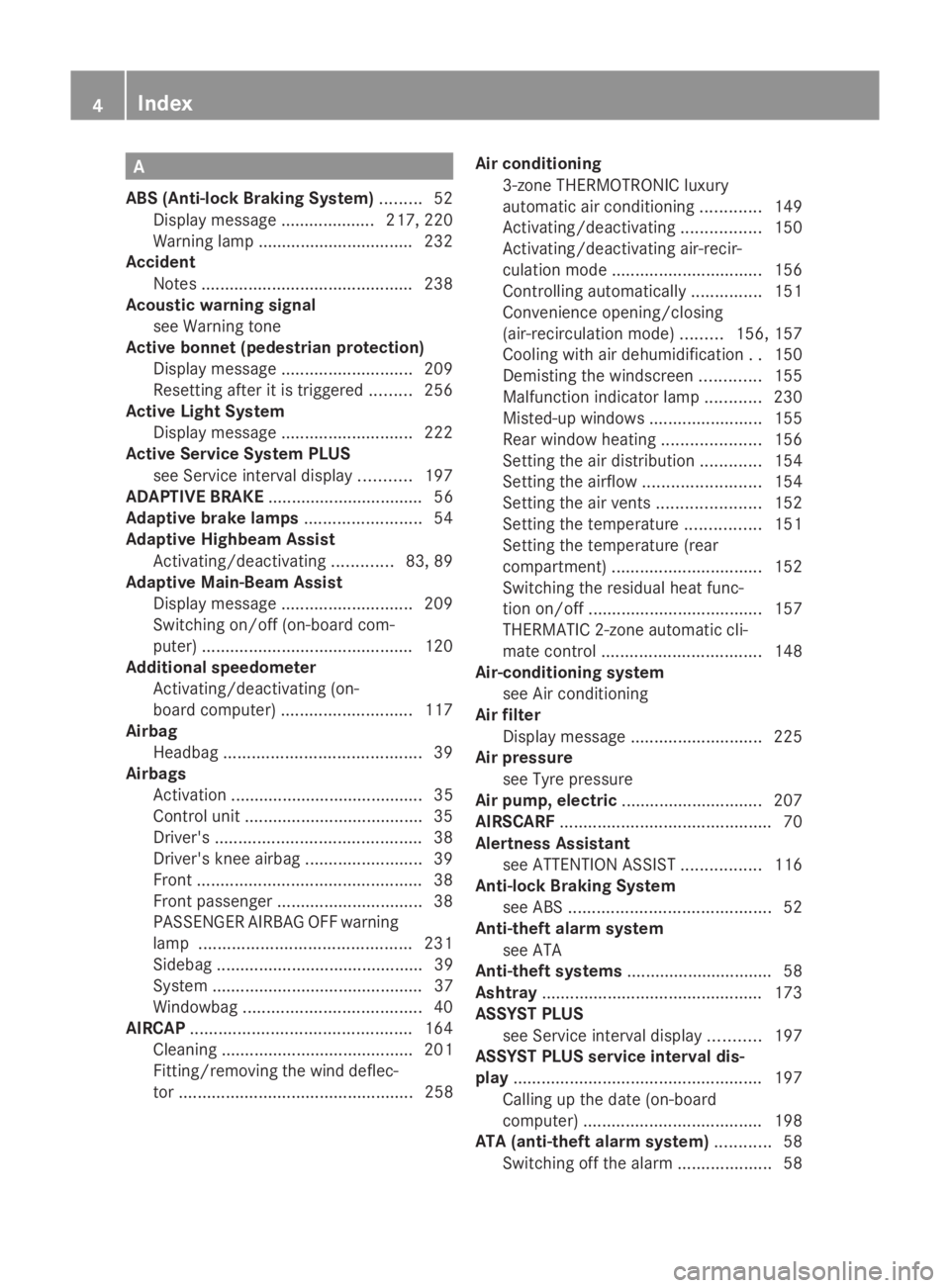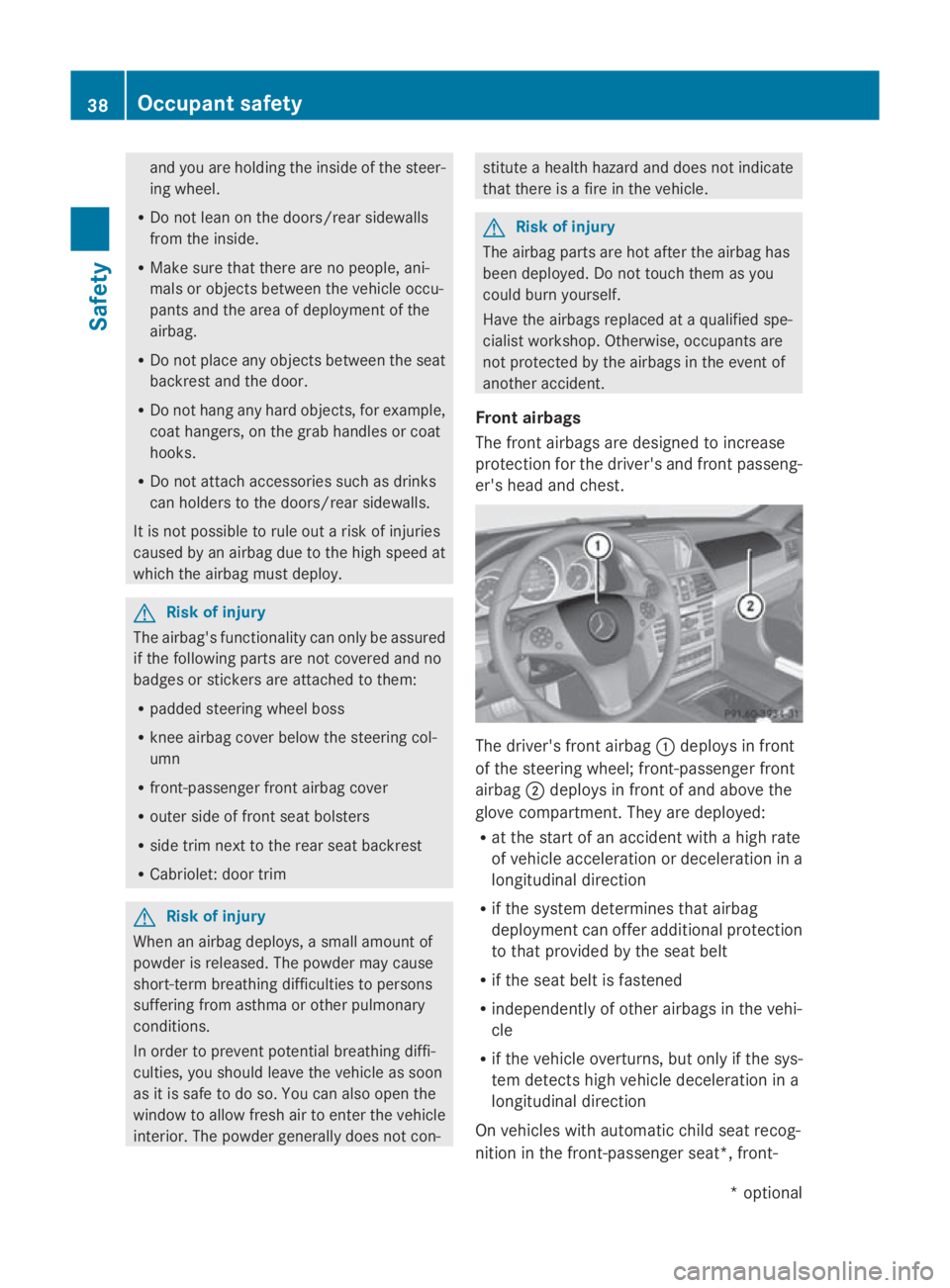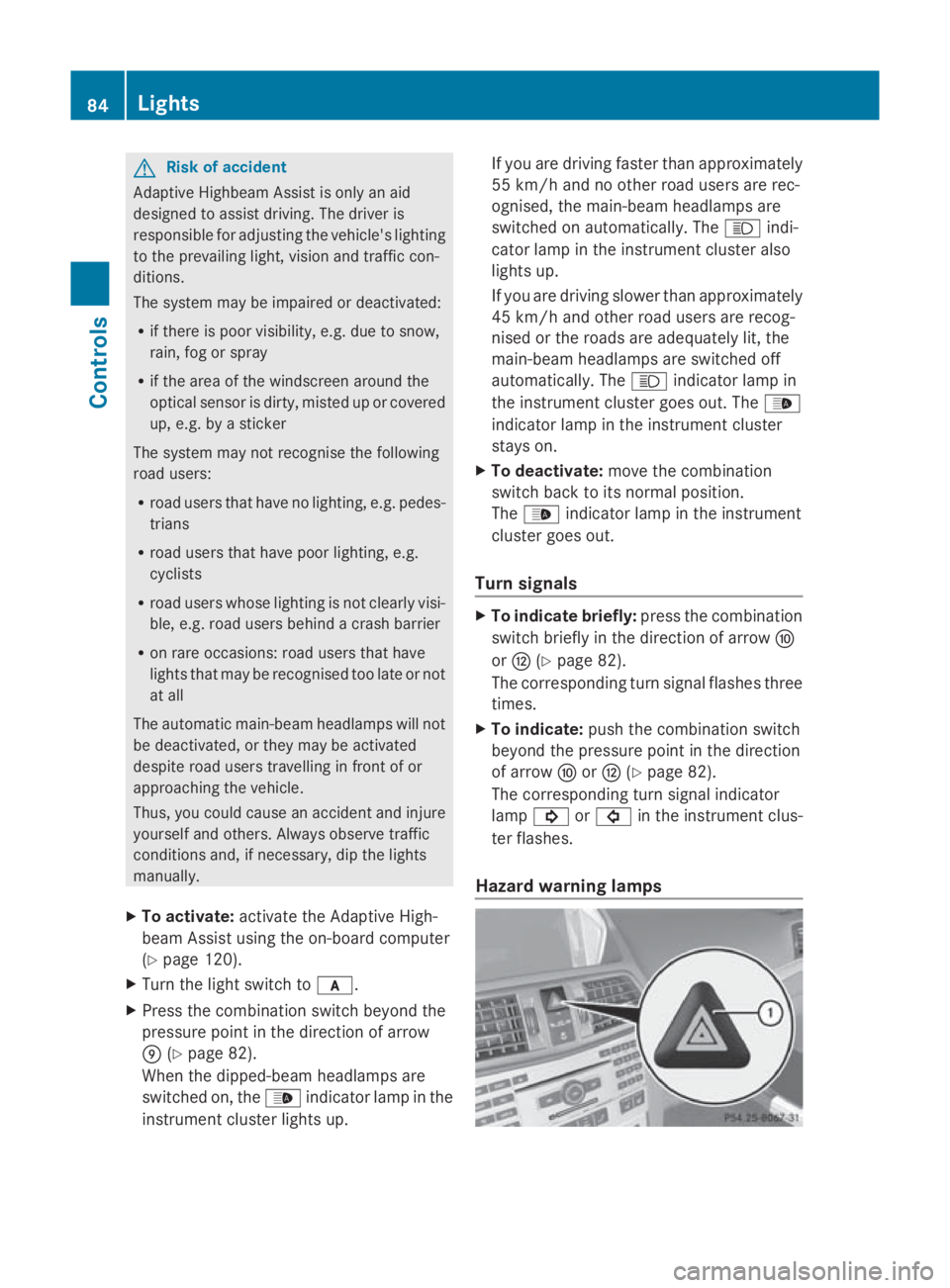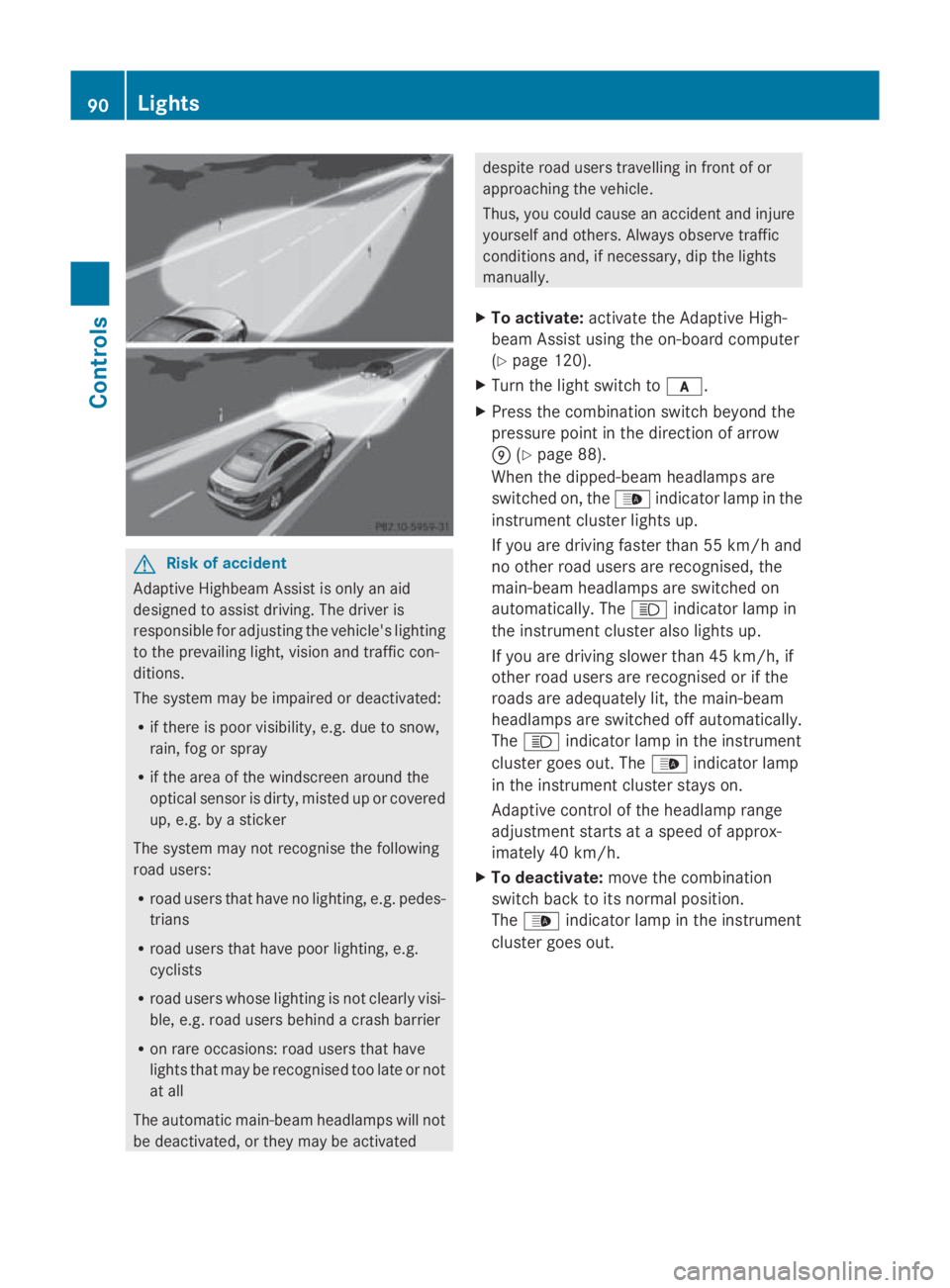air condition MERCEDES-BENZ E-CLASS COUPE 2009 Owners Manual
[x] Cancel search | Manufacturer: MERCEDES-BENZ, Model Year: 2009, Model line: E-CLASS COUPE, Model: MERCEDES-BENZ E-CLASS COUPE 2009Pages: 313, PDF Size: 7.76 MB
Page 7 of 313

A
ABS (Anti-lock Braking System) .........52
Display message .................... 217, 220
Warning lamp ................................. 232
Accident
Notes ............................................. 238
Acousti cwarning signal
see Warning tone
Active bonnet (pedestrian protection)
Display message ............................ 209
Resetting after it is triggered .........256
Active Light System
Display message ............................ 222
Active Service Syste mPLUS
see Service interva ldispla y........... 197
ADAPTIVE BRAKE ................................. 56
Adaptive brake lamps .........................54
Adaptive Highbeam Assist Activating/deactivating .............83, 89
Adaptive Main-Beam Assist
Display message ............................ 209
Switching on/off (on-board com-
puter) ............................................. 120
Additional speedometer
Activating/deactivating (on-
board computer) ............................ 117
Airbag
Headbag .......................................... 39
Airbags
Activatio n......................................... 35
Control unit ...................................... 35
Driver's ............................................ 38
Driver's knee airba g......................... 39
Front ................................................ 38
Front passenger ............................... 38
PASSENGER AIRBAG OFF warning
lamp ............................................. 231
Sidebag ............................................ 39
System ............................................. 37
Windowba g...................................... 40
AIRCAP ............................................... 164
Cleaning ......................................... 201
Fitting/removing the wind deflec-
tor .................................................. 258 Airc
onditioning
3-zone THERMOTRONIC luxury
automatic airc onditioning.............149
Activating/deactivating .................150
Activating/deactivating air-recir-
culation mode ................................ 156
Controlling automatically ...............151
Convenience opening/closing
(air-recirculatio nmode)......... 156, 157
Cooling with aird ehumidification..150
Demisting the windscreen .............155
Malfunction indicator lamp ............230
Misted-up windows ........................155
Rea rwindow heating ..................... 156
Setting the aird istribution.............154
Setting the airflow .........................154
Setting the airv ents...................... 152
Setting the temperature ................151
Setting the temperature (rear
compartment) ................................ 152
Switching the residua lheatfunc-
tion on/off ..................................... 157
THERMATI C2-zone automatic cli-
mate control .................................. 148
Air-conditionin gsystem
see Air conditioning
Airf ilter
Display message ............................ 225
Airp ressure
see Tyr epressure
Airp ump, electric .............................. 207
AIRSCARF ............................................. 70
Alertnes sAssistant
see ATTENTION ASSIST .................116
Anti-loc kBraking System
see ABS ........................................... 52
Anti-theft alarm system
see ATA
Anti-theft systems ............................... 58
Ashtray ............................................... 173
ASSYST PLUS see Service interva ldispla y........... 197
ASSYST PLU Sservice interval dis-
play ..................................................... 197
Calling up the date (on-board
computer) ...................................... 198
ATA (anti-theft alarm system) ............58
Switching off the alarm ....................584
Index 207_AKB; 2; 3, en-GB
mkalafa,
Version: 2.11.8.1 2009-07-23T10:23:49+02:00-Seite 4
Page 12 of 313

Loss
............................................... 239
Petrol ............................................. 179
Fue lcon sumption
Current (on-board computer) .........111
Notes ............................................. 288
Fue lfiller flap
Opening/closing ........................... 178
Fue lfilter
Display message ............................ 221
Fue lgauge ............................................ 25
Fue llevel
Calling up the range (on-board
computer) ...................................... 111
Gauge .............................................. 25
Fue lline
Malfunction ................................... .239
Fue ltank
Defect ............................................ 239
Fuse allocatio nchart ........................ 280
Fuse box Boot ............................................... 281
Dashboard ..................................... 281
Engine compartment .....................281
Fuses .................................................. 280G
Gear indicator .................................... 102
Genuine Mercedes-Benz parts .........284
Glove compartment ..........................166 H
Headbag ............................................... 39
Headlamp cleaning system ..............183
Headlamps Cleaning ......................................... 202
Cleaning system .............................. 93
Misting up ...................................... 244
Head restraint
Lowering manually (rear) ...............257
Head restraints
Adjusting (front) ............................... 68
Adjusting (rear) ................................ 69
NECK-PR O....................................... 41
Resetting triggered NECK-PRO
hea drestraints .............................. 257Heating
see Air conditioning
High-pressure cleaners ....................199
Hill start assist .................................. 100
HOLD function ................................... 135
Display message ...........210, 212, 220
Hook ................................................... 171 I
Immobiliser .......................................... 58
Indicator and warning lamps ...........232
Automatic chil dseatrecognition
(malfunction) ................................. 231
Brakes (red )................................... 234
Coolant .......................................... 234
Engine diagnostics .........................235
PASSENGER AIRBAG OFF ........44, 231
Reserve fuel ................................... 237
Seat bel t........................................ 236
SRS .......................................... 35, 233
THERMOTRONIC (malfunction) ......230
Indicator lamps
see Indicator and warning lamps
Instrument cluster ............................106
On-board computer .......................117
Overview .......................................... 25
Instrument lighting .............................25
see Instrument cluster lighting
Intelligen tLight System
Display message ............................ 223
On-board computer .......................119
Setting dipped-bea mheadlamps
for driving on the right/left (on-
board computer) ............................ 119
Interior lighting
Automatic control system ................93
Delayeds witch-off (on-board
computer) ...................................... 120
Emergency lighting ..........................93
Manual control ................................ .93
Readin glamp ................................... 93
Interior motio nsensor ........................ 59
ISOFIXc hild seat securing system ....50 Index
9 207_AKB; 2; 3, en-GB
mkalafa,
Version: 2.11.8.1 2009-07-23T10:23:49+02:00-Seite 9
Page 41 of 313

and you are holding th
einside of th esteer-
ing wheel.
R Do no tlean on th edoors/rear sidewalls
from th einside.
R Mak esure that there are no people, ani-
mals or object sbetween th evehicle occu-
pant sand th earea of deploymen tofthe
airbag.
R Do no tplace any object sbetween th eseat
backres tand th edoor.
R Do no thanga ny hard objects, for example,
coat hangers, on th egrab handles or coat
hooks.
R Do no tattach accessories suc hasdrinks
can holders to th edoors/rear sidewalls.
It is no tpossible to rule out arisk of injuries
caused by an airbag due to th ehigh spee dat
whic hthe airbag must deploy. G
Ris
kofi njury
The airbag's functionalit ycan only be assured
if th efollowin gpartsa re no tcovered and no
badges or stickers are attached to them:
R padded steering wheel boss
R knee airbag cover below th esteering col-
umn
R front-passenger fron tairbag cover
R outer side of fron tseat bolsters
R side trim nex ttotherear seat backrest
R Cabriolet :door trim G
Ris
kofi njury
When an airbag deploys, asmall amoun tof
powder is released. The powder may cause
short-term breathin gdifficulties to persons
sufferin gfroma sthma or other pulmonary
conditions.
In orde rtoprevent potential breathin gdiffi-
culties, you shoul dleave th evehicle as soon
as it is safe to do so. You can also open the
window to allow fresh air to enter th evehicle
interior. The powder generally does no tcon- stitut
eahealthhazard and does no tindicate
that there is afireint hevehicle. G
Ris
kofi njury
The airbag part sare hot after th eairbag has
been deployed. Do no ttou ch them as you
coul dburn yourself.
Hav ethe airbag sreplaced at aqualified spe-
cialis tworkshop .Otherwise, occupant sare
no tp rotected by th eairbag sintheeven tof
another accident.
Fron tairbags
The fron tairbag sare designed to increase
protection for th edriver' sand fron tpasseng-
er' sh ead and chest. The driver'
sfront airbag 0046deploys in front
of th esteering wheel; front-passenger front
airbag 0047deploys in fron tofand above the
glov ecompartment. They are deployed:
R at th estart of an acciden twith ahigh rate
of vehicle acceleratio nordeceleratio nina
longitudinal direction
R if th esystem determine sthata irbag
deployment can offer additional protection
to that provided by th eseat belt
R if th eseat belt is fastened
R independently of other airbag sinthevehi-
cle
R if th evehicle overturns, but only if th esys-
te md etect shigh vehicle deceleratio nina
longitudinal direction
On vehicle swith automatic child seat recog-
nition in th efront-pa ssenger seat*, front- 38
Occupant safetySafety
*o
ptional
207_AKB
;2;3,en-GB
mkalafa, Version:2.11.8.1
2009-07-23T10:23:49+02:00
-Seite 38
Page 64 of 313

Opening and closing
...........................62
Boot ...................................................... 64
Key positions ....................................... 65
Seats .................................................... 66
Steering wheel .................................... 71
Mirrors ................................................. 73
Memor yfunctions* ............................. 75
Seat belts ............................................. 76
Lights ................................................... 80
Windscreen wipers .............................94
Side windows ...................................... 94
Driving and parking ............................98
Transmission ..................................... 101
Instrument cluster ............................106
On-boar dcomputer .......................... 107
Driving systems ................................ 122
Air conditioning ................................. 147
Sliding sunroof (Coupé) ....................158
Soft top (Cabriolet) ...........................160
Loading and stowing ........................165
Features ............................................. 172 61Controls
207_AKB
;2;3,en-GB
mkalafa, Version:2.11.8.1
2009-07-23T10:23:49+02:0
0-Seite 61
Page 70 of 313

childre
nshoul dnever be left unsupervised in
the vehicle .The yc ould become trapped when
adjusting aseat G
Risk of accident
Only adjust the driver' sseatw hent he vehicle
is stationary. You will otherwise be distracted
from the roa dand traffi cconditions and you
could los econtrol of the vehicle as aresult of
the sea tmoving. Thi scould cause an acci-
dent. G
Risk of injury
Make sure that nobody can become trapped
whe nyou adjust the seat.
Observe the notes concerning the airba gsys-
tem.
Secure childre nasrecommended; see the
"Childre ninthe vehicle "section. G
Risk of injury
Make sure that the centra lareaoft he head
restraint supports the back of your hea dat
abou teye level .You could seriously injure
your neck if your hea disnot correctly sup-
ported by the hea drestraint in the event of an
accident. Neve rtrave lwithou tac orrectly
adjuste dand engaged hea drestraint.
! Whe nyou move the seats, make sure that
there are no objects in the footwel lor
behind the seats. Otherwise, yo ucould
damag ethe seats and the objects.
i The hea drestraints in the front seats are
fitted with the NECK-PR Osystem
(Y page 41). For this reason, it is not pos-
sible to remove the hea drestraints from
the front seats.
Pleas econtact aMercedes-Benz Service
Centre for more information. Adjusting the seats manually and
electrically
Seat fore-and-aft adjustment
X
Lift handle 0088and slide the sea tforwards
or backwards.
Backrest angle X
Slide the button forward sorbackint he
direction of arrow 0046.
Seat height X
Slide the button up or dow ninthe direction
of arrow 0047.
Seat cushio nangle Adjus
tthe angl esothat your thighs are gently
supported.
X Turn thumbwheel 008Ain the desire ddirec-
tion. Seats
67Controls
207_AKB;2;3,en-GB
mkalafa ,V ersion: 2.11.8.1
2009-07-23T10:23:49+02:00
-Seite 67 Z
Page 72 of 313

someone becoming trapped, press the seat
adjustment switch on the door.
Folding the backrest forwards X
Vehicles without the memory func-
tion*: if necessary, release the head
restraint and push it down.
X Pull seat release handle 0046forwards and
fold the backrest forwards, until the seat
backrest engages.
X Push the seat as far forwards as it will go.
X Vehicles with the memory function*:
pull seat release handle 0046forwards and
fold the backrest forwards as far as it will
go.
The seat moves automaticallytot he fore-
most position.
Folding back the backrest X
Vehicles without the memory func-
tion*: push the seat backrest back hori-
zontally until the seat reaches the position
that was previouslys et.
X Swing back the seat backrest evenly below
release handle 0046until it engages, doing so
in as mooth manner.
X If the head restraint has been moved, check
the position of the head restraint and set it
to the correct position after the seat back-
rest has been folded back.
X Vehicles with the memory function*:
swing back the seat backrest.
The seat moves automaticallytot he stored
position. G
Risk of injury
Make sure that the backrest engages fully.If
the seat backrest is not engaged, the mes-
sage Front right seat backrest not
locked orFront left seat backrest
not locked appears in the multi-function dis-
play.S top the vehicle as soon as road and
traffic conditions permit and remove any
objects that are blocking the backrest. Rear head restraint (Cabriolet)
Lowering and extending the head
restraints from the front X
Make sure that the key is in position 2in
the ignition lock.
X To lower: press button 0046.
The head restraints move to the lowest
position.
If AIRCAP* is activated (Y page 164), the
right-hand indicator lamp on the AIRCAP*
button goes out.
X To extend: press button 0046again.
The head restraints only move into the cen-
tral position if AIRCAP* is activated and no
rear seat belt has been fastened.
If AIRCAP* is activated (Y page 164), the
right-hand indicator lamp on the AIRCAP*
button comes on.
i More detailed information aboutA IR-
CAP* can be found on (Y page 164). 4-way lumbar support*
You can adjust the contour of the front seat
backrests individually to provide optimum
support for your back. Seats
69Controls
*optional
207_AKB;2;3,e
n-GB
mkalafa, Version: 2.11.8.1 2009-07-23T10:23:49+02:00-Seite 69 Z
Page 83 of 313

Correct driver's seat position
Example
:Coupé G
Ris
kofa ccident
Only adjust th edriver' sseat when th evehicle
is stationary. You will otherwise be distracted
from th eroad and traffic condition sand you
coul dlose control of th evehicle as aresult of
th es eat moving .This coul dcaus eana cci-
dent. G
Ris
kofa ccident
Only adjust th esteering wheel when th evehi-
cle is stationar yand do no tpull away until the
steering wheel adjustmen tmechanism is
locke dinposition. Otherwise, you migh tdrive
without th esteering wheel adjustmen tmech-
anis mbeinglocke dinp ositio nand be distrac-
te df romr oad and traffic condition sbyan
unexpected movement of th esteering wheel
and caus eanaccident.
However, th esteerabilit yofthevehicle is not
affected.
X Chec kwhether seat 008Aand th ehead
restraint are adjusted properly
(Y page 66). Mak
esure that:
R you are as far away from th edriver' sfront
airbag as possible.
R you are sittin ginanormalupright posi-
tion.
R you can fasten th eseat belt properly.
R you have moved th ebackres ttoan
almos tvertical position.
R you have set th eseat angle so that your
thighs are gently supported.
R you can depress th epedals properly.
R you have adjusted th ehead restraint so
that th eback of your head is supported
at eye leve lbythecentral area of the
head restraint.
X Chec kwhether steering wheel 0046is adjus-
te dp roperl y(Ypage 71).
Mak esure that:
R you can hold th esteering wheel wit hyour
arm sslightly bent.
R you can mov eyour legs freely.
R you can see all th edisplays in th einstru-
men tcluste rclearly.
X Chec kwhether you have fastened seat
belt 0047properl y(Ypage 76).
It should:
R fit snugly across your body.
R be routed across th emiddle of your
shoulder.
R be routed in your pelvic area across the
hip joints. Lights
Exterior lightin
g(Coupé)
Notes on th eexterior lighting For reason
sofsafety, Mercedes-Ben zrecom-
mends that you driv ewitht he light sswitched
on eve ndurin gthe daytime. In som ecoun- 80
LightsControls
207_AKB
;2;3,en-GB
mkalafa ,V ersion: 2.11.8.1
2009-07-23T10:23:49+02:00
-Seite 80
Page 87 of 313

G
Risk of accident
Adaptiv eHighbea mAssist is only an aid
designe dtoassist driving .The driver is
responsibl efor adjusting the vehicle's lighting
to the prevailing light, vision and traffi ccon-
ditions.
The system may be impaired or deactivated:
R if there is poo rvisibility ,e.g. du etosnow,
rain, fog or spray
R if the are aofthe windscreen around the
optical senso risdirty, misted up or covered
up ,e.g. by asticker
The system may not recognise the following
roa dusers:
R roa dusers that have no lighting, e.g. pedes-
trians
R roa dusers that have poo rlighting, e.g.
cyclists
R roa dusers whose lighting is not clearl yvisi-
ble, e.g. roa dusers behind acras hb arrier
R on rar eoccasions: roa dusers that have
lights that may be recognise dtoo late or not
at all
The automatic main-bea mheadlamp swilln ot
be deactivated, or they may be activated
despite roa dusers travelling in front of or
approaching the vehicle.
Thus, yo ucould cause an accident and injure
yoursel fand others. Alway sobserve traffic
conditions and ,ifnecessary, di pthe lights
manually.
X To activate: activate the Adaptiv eHigh-
bea mA ssist using the on-board computer
(Y page 120).
X Turn the light switch to 0066.
X Press the combination switch beyond the
pressure point in the direction of arrow
0070 (Ypage 82).
Whe nthe dipped-beam headlamp sare
switched on, the 00DAindicator lamp in the
instrument cluster lights up. If yo
uare driving faster than approximately
55 km/h and no othe rroa du sers are rec-
ognised ,the main-bea mheadlamp sare
switched on automatically. The 0063indi-
cator lamp in the instrument cluster also
lights up.
If yo uare driving slowe rthan approximately
45 km/h and othe rroa du sers are recog-
nise dort he roads are adequatel ylit,t he
main-bea mheadlamp sare switched off
automatically. The 0063indicator lamp in
the instrument cluster goe sout.T he 00DA
indicator lamp in the instrument cluster
stay son.
X To deactivate: move the combination
switch back to its norma lposition.
The 00DA indicator lamp in the instrument
cluster goe sout.
Turn signals X
To indicate briefly: press the combination
switch briefl yinthe direction of arrow 0071
or 0073 (Ypage 82).
The corresponding turn signal flashe sthree
times.
X To indicate: push the combination switch
beyond the pressure point in the direction
of arrow 0071or0073 (Ypage 82).
The corresponding turn signal indicator
lamp 0024 or0026 in the instrument clus-
ter flashes.
Hazard warnin glamps 84
LightsControls
207_AKB
;2;3,en-GB
mkalafa ,V ersion: 2.11.8.1
2009-07-23T10:23:49+02:00
-Seite 84
Page 88 of 313

The hazard warning lamps automatically
switch on if:
R
an airbag is deployed.
R you brake sharply and bring the vehicle to
ah alt from aspeed of more than
70 km/h.
The hazard warning lamps still operate if the
ignition is switched off.
X To switch on: press button0046.
All turn signals flash.
X To switch off: press button0046.
X To switch off the hazard warning lamps
using the combination switch: if the haz-
ard warning lamps are on, push the combi-
nation switch in the direction of arrow 0071
or 0073 beyond the pressure point
(Y page 82).
The indicator lamp on the corresponding
side of the vehicle flashes.
The hazard warning lamp switches off auto-
matically after full brake application if the
vehicle then reaches aspeed of over
10 km/ha gain.
Intelligent Light System* (bi-xenon
headlamps*) The Intelligent Light System is
asystem which
adjusts the headlamps automatically to suit
the prevailing driving and weather conditions.
The bi-xenon headlamps offer enhanced func-
tions to improve illumination of the road sur-
face, e.g. depending on the vehicle speed or
weather conditions. The system includes the
active light function, cornering light function,
motorway mode and extended range fog-
lamps. The system is only active when it is
dark.
You can activat eordeactivate the "Intelligent
Light System" using the on-board computer
(Y page 119). Active light function
The active light function is
asystem that
moves the headlamps accordin gtothe steer-
ing movements of the frontw heels. In this
way, relevant areas remain illuminated while
driving. This allows you to recognise pedes-
trians, cyclists and animals.
Cornering light function The cornering light function improves the illu-
mination of the road over
awide angle in the
direction you are turning, enabling better vis-
ibility in tight bends, for example. It can only
be activated when the dipped-beam head-
lamps are switched on.
Active:
R if you are driving at speeds below
40 km/h, the cornering light function is
activated either by the turn signal or by the
steerin gwheel being turned.
R if you are driving at speeds between
40 km/ha nd 70 km/h ,the cornerin glight
function is activated by th esteering wheel
bein gturned. Lights
85Controls
*optional
207_AKB
;2;3,en-GB
mkalafa ,V ersion: 2.11.8.1
2009-07-23T10:23:49+02:00
-Seite 85 Z
Page 93 of 313

G
Risk of accident
Adaptiv eHighbea mAssist is only an aid
designe dtoassist driving .The driver is
responsibl efor adjusting the vehicle's lighting
to the prevailing light, vision and traffi ccon-
ditions.
The system may be impaired or deactivated:
R if there is poo rvisibility ,e.g. du etosnow,
rain, fog or spray
R if the are aofthe windscreen around the
optical senso risdirty, misted up or covered
up ,e.g. by asticker
The system may not recognise the following
roa dusers:
R roa dusers that have no lighting, e.g. pedes-
trians
R roa dusers that have poo rlighting, e.g.
cyclists
R roa dusers whose lighting is not clearl yvisi-
ble, e.g. roa dusers behind acras hb arrier
R on rar eoccasions: roa dusers that have
lights that may be recognise dtoo late or not
at all
The automatic main-bea mheadlamp swilln ot
be deactivated, or they may be activated despite roa
dusers travelling in front of or
approaching the vehicle.
Thus, yo ucould cause an accident and injure
yoursel fand others. Alway sobserve traffic
conditions and ,ifnecessary, di pthe lights
manually.
X To activate: activate the Adaptiv eHigh-
bea mA ssist using the on-board computer
(Y page 120).
X Turn the light switch to 0066.
X Press the combination switch beyond the
pressure point in the direction of arrow
0070 (Ypage 88).
Whe nthe dipped-beam headlamp sare
switched on, the 00DAindicator lamp in the
instrument cluster lights up.
If yo uare driving faster than 55 km/h and
no othe rroa du sers are recognised, the
main-bea mheadlamp sare switched on
automatically. The 0063indicator lamp in
the instrument cluster also lights up.
If yo uare driving slowe rthan 45 km/h ,if
othe rroa du sers are recognise dorifthe
roads are adequatel ylit,t he main-beam
headlamp sare switched off automatically.
The 0063 indicator lamp in the instrument
cluster goe sout.T he 00DA indicator lamp
in the instrument cluster stay son.
Adaptiv econtrol of the headlamp range
adjustment starts at aspeed of approx-
imately 40 km/h.
X To deactivate: move the combination
switch back to its norma lposition.
The 00DA indicator lamp in the instrument
cluster goe sout. 90
LightsControls
207_AKB
;2;3,en-GB
mkalafa ,V ersion: 2.11.8.1
2009-07-23T10:23:49+02:00
-Seite 90